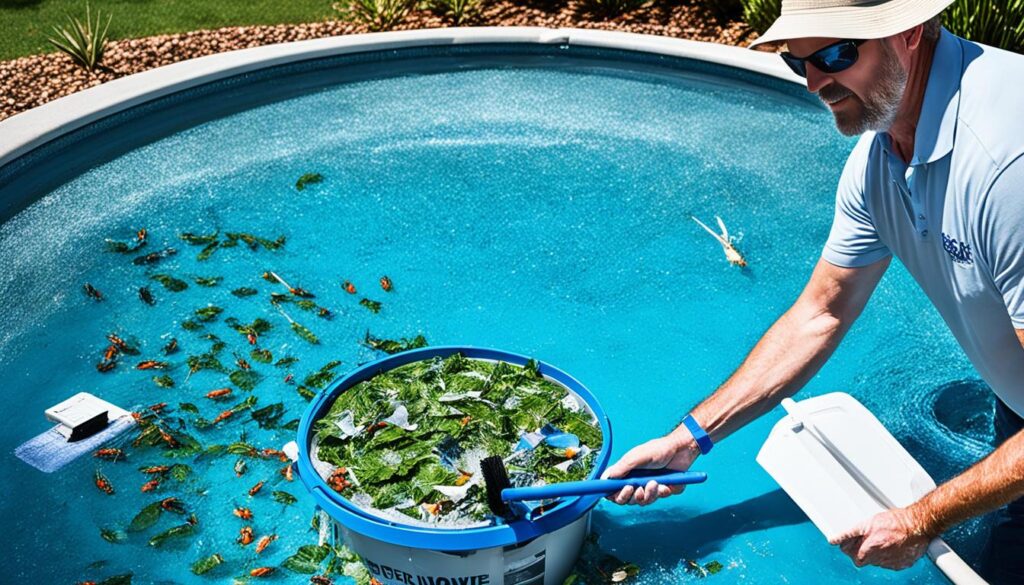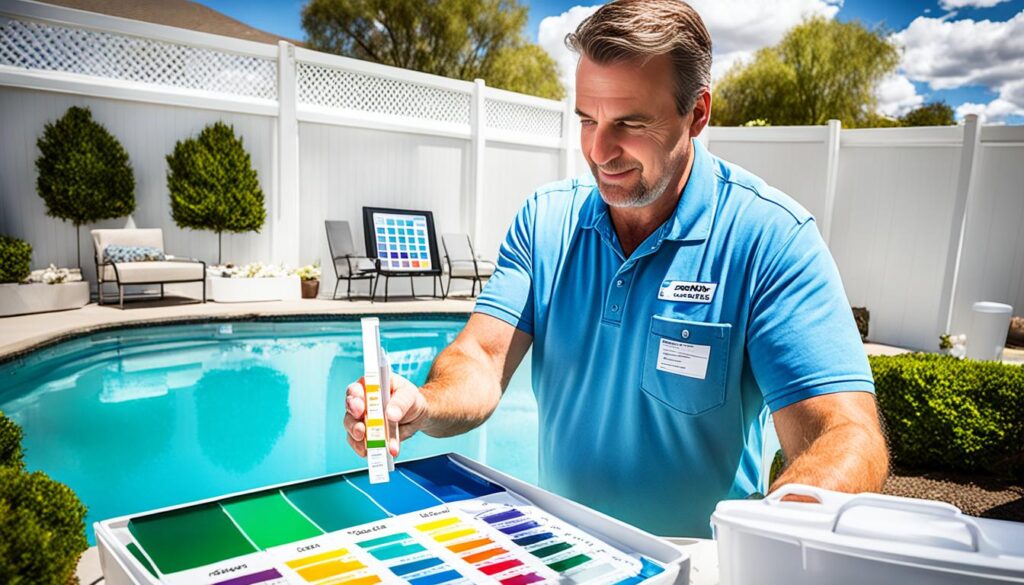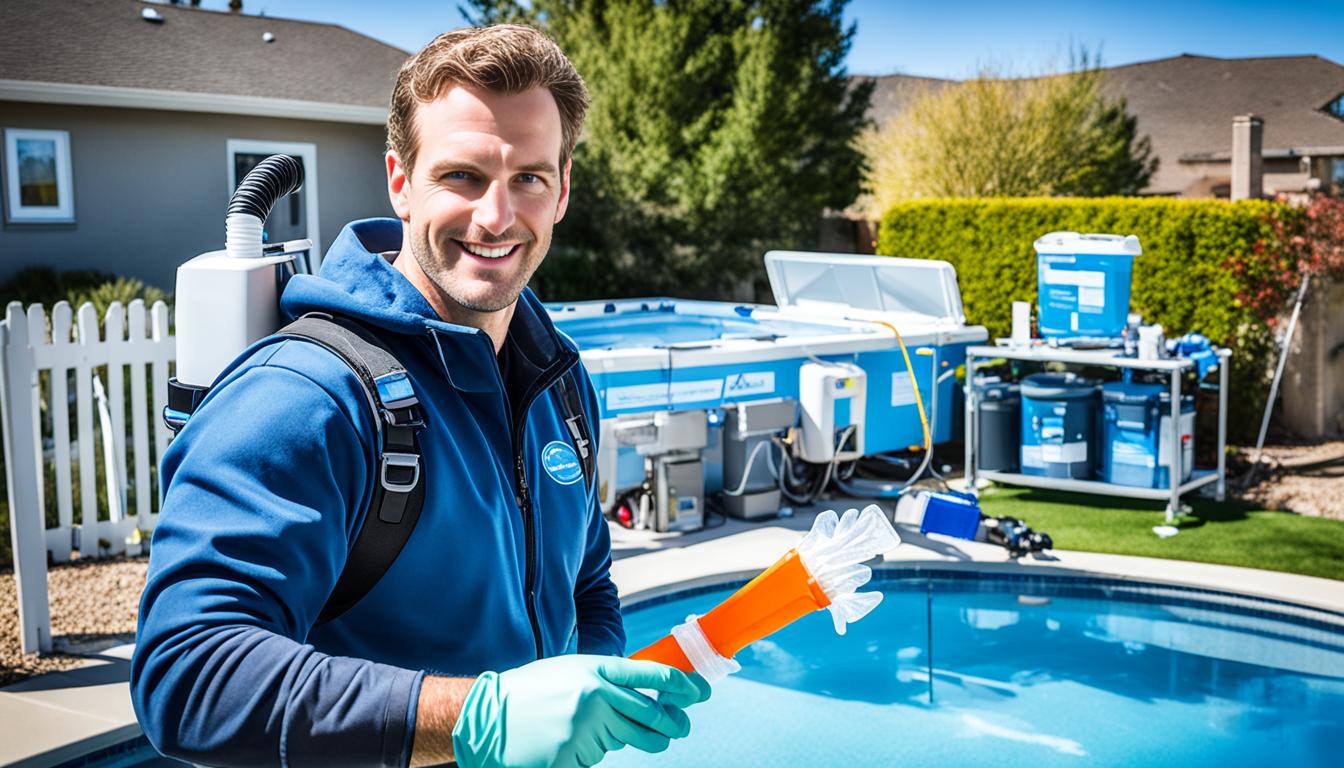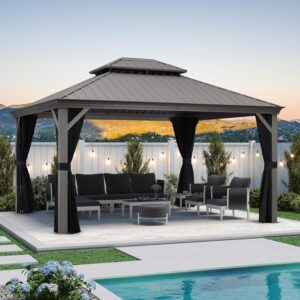Welcome to our beginner’s guide to pool maintenance! If you’re a new pool owner or just starting your journey into pool care, this comprehensive guide is here to help you understand the pool maintenance basics. With our easy tips and tricks, you’ll be able to keep your pool clean and well-maintained, ensuring that it remains a refreshing oasis throughout the swimming season.
Maintaining a pool may seem overwhelming at first, but with the right knowledge and a little effort, it can be a straightforward and rewarding task. By following these simple guidelines, you’ll have the confidence to tackle pool maintenance with ease, keeping your pool water crystal clear and inviting for all to enjoy. Let’s dive in!
Key Takeaways:
- Understanding the basics of pool maintenance is essential for beginners.
- Regular cleaning and skimming of the pool surface help prevent debris buildup.
- Proper vacuuming and brushing techniques keep the pool floor and walls clean and free from dirt and algae.
- Regularly checking and maintaining the pool filter ensures efficient water circulation.
- Balancing pool chemicals is crucial for maintaining clean and safe pool water.
Understanding Pool Water Chemistry
Proper pool water chemistry is crucial for maintaining a clean and safe swimming environment, especially for beginners. By understanding the essential aspects of pool water chemistry, you can ensure that your pool is well-balanced and free from harmful contaminants.
One of the key factors in pool water chemistry is maintaining the pH balance. pH measures the acidity or alkalinity of the pool water and should be kept between 7.2 and 7.8 for optimal swimmer comfort and effective chemical sanitization. Low pH levels can cause eye and skin irritation, while high pH levels can reduce the effectiveness of chlorine. Regularly testing and adjusting the pH level is essential to prevent these issues.
Chlorine is another critical component of pool water chemistry. It acts as a disinfectant, killing bacteria and algae, and maintaining clear and healthy water. The ideal chlorine level for most pools is between 2.0 and 4.0 parts per million (ppm). Low chlorine levels can lead to the growth of algae and harmful bacteria, while high levels can cause skin and eye irritation. Regularly testing and adjusting the chlorine levels will help maintain a safe and enjoyable swimming experience.
In addition to pH and chlorine, there are other factors that contribute to pool water chemistry. These include alkalinity, calcium hardness, and cyanuric acid levels. Alkalinity helps stabilize the pH level and should be kept between 80 and 120 ppm. Calcium hardness prevents the water from becoming too aggressive and should be maintained between 200 and 400 ppm. Cyanuric acid, also known as stabilizer, protects chlorine from sunlight degradation and should be kept between 30 and 50 ppm.
To ensure proper pool water chemistry, regular testing using water test kits is essential. These kits typically measure pH, chlorine, alkalinity, and other important parameters. Based on the test results, you can make adjustments by adding chemicals as needed. Consulting with a pool professional or using a pool maintenance app can also be helpful for beginners.
Remember, maintaining proper pool water chemistry is not a one-time event. It requires regular monitoring and adjustments to ensure a safe and enjoyable swimming experience.
The Importance of Pool Water Chemistry
Poor pool water chemistry can not only affect the clarity and quality of the water but also pose health risks to swimmers. An unbalanced pool can lead to the growth of harmful bacteria, algae, and other contaminants. These can cause skin and eye irritation, respiratory issues, and even infections.
By understanding and maintaining proper pool water chemistry, beginners can create a clean and safe swimming environment for themselves and their families. Regular testing, adjusting chemical levels, and keeping equipment well-maintained are the keys to achieving optimal pool water chemistry.
Ideal Parameters for Pool Water Chemistry
| Parameter | Ideal Range |
|---|---|
| pH | 7.2 – 7.8 |
| Chlorine | 2.0 – 4.0 ppm |
| Alkalinity | 80 – 120 ppm |
| Calcium Hardness | 200 – 400 ppm |
| Cyanuric Acid | 30 – 50 ppm |
Regularly testing these parameters and making necessary adjustments will help maintain clean, clear, and inviting pool water for a great swimming experience.
CLICK HERE to find some test strips on Amazon to test your water
Skimming and Cleaning the Pool Surface
Regular skimming and cleaning of the pool surface is crucial for maintaining a clean and inviting swimming pool. Debris, leaves, and other contaminants can quickly accumulate on the surface, affecting the water quality and overall pool appearance. Follow these step-by-step tips and keep your pool in pristine condition.
Step 1: Gather the Necessary Tools
Before starting the cleaning process, make sure you have the following tools with links to purchase on Amazon:

Step 2: Skim the Pool Surface
Using the pool skimmer net attached to the telescopic pole, skim the water surface to remove any floating debris. Move the net across the water, focusing on areas where leaves, insects, or other debris gather. Be thorough and take your time to ensure you remove as much debris as possible.
Pro Tip: Skim your pool at least once a day, or more frequently during periods of high debris accumulation, such as autumn.
Step 3: Use the Leaf Rake
If there are larger leaves or debris that the skimmer net couldn’t catch, use a leaf rake to scoop them out. Attach the leaf rake to the telescopic pole and gently skim the bottom of the pool, corners, and steps to remove any remaining debris.
Step 4: Brush the Pool Walls and Floor
Brushing the pool walls and floor is essential to prevent the buildup of algae and other contaminants. Use a pool brush attached to the telescopic pole to scrub the walls and floor in a circular motion. Pay special attention to areas where algae or dirt are visible. Brushing helps loosen and remove stubborn dirt, ensuring a cleaner pool.
Pro Tip: Brush your pool at least once a week to maintain a clean and algae-free surface.
Step 5: Skim Again and Empty the Skimmer Basket
After brushing, skim the pool surface once again to remove any loosened dirt or debris. Once you’ve finished skimming, don’t forget to empty the skimmer basket. A full skimmer basket can hinder the skimming process, reducing its effectiveness.
Step 6: Rinse and Store the Tools
After completing the cleaning process, rinse the tools thoroughly with clean water and allow them to dry before storing them. This prevents any mold or mildew growth and ensures the tools remain in good condition for future use.
Remember: Skimming and cleaning the pool surface is an ongoing task. Regular maintenance is key to preventing debris buildup and maintaining a clean and enjoyable swimming pool.
| Pool Cleaning Tips | Pool Maintenance Tips | Beginner Pool Care |
|---|---|---|
| Skim the pool surface daily | Follow a regular pool maintenance schedule | Start with basic pool care practices |
| Use a leaf rake to remove larger debris | Balance pool chemicals regularly | Learn about pool water chemistry |
| Brush the pool walls and floor weekly | Check and maintain pool equipment | Prevent algae growth in your pool |
Vacuuming and Brushing the Pool
Properly vacuuming and brushing your pool is crucial for maintaining a clean and algae-free swimming environment. In this section, we will guide beginners through the techniques and tools required to ensure a spotless pool surface and walls.
The Importance of Vacuuming
Vacuuming your pool regularly helps remove dirt, debris, and other particles that can accumulate on the pool floor. This not only keeps the water clean but also prevents the growth of algae and bacteria. Follow these steps to vacuum your pool effectively:
- Start by assembling your pool vacuum system according to the manufacturer’s instructions.
- Attach the vacuum head to the telescopic pole and connect it to the vacuum hose.
- Submerge the vacuum head and hose into the pool, making sure all air bubbles are released.
- Connect the hose to the skimmer or designated vacuum port to create suction.
- Gently move the vacuum head along the pool floor, covering every inch to remove dirt and debris.
- Continue vacuuming until the entire pool floor is clean.
- Once finished, turn off the filtration system and disconnect the vacuum.
Manual Pool Vacuum available on Amazon
Robotic Pool Vacuum available on Amazon
Brushing the Pool Walls
In addition to vacuuming, brushing the pool walls helps remove algae and prevent the buildup of dirt and grime. Here’s how to brush your pool effectively:
- Select a pool brush suitable for your pool’s surface material.
- Starting from the top, gently scrub the pool walls in a circular motion, working your way down.
- Pay extra attention to areas where dirt, algae, or stains are visible.
- If you encounter stubborn stains, use a specialized pool wall cleaner and follow the manufacturer’s instructions.
- After brushing, use a pool skimmer or vacuum to remove any loosened debris.
Vacuuming and brushing your pool should be performed on a regular basis to maintain optimal cleanliness. By incorporating these pool cleaning tips into your maintenance routine, you’ll ensure a pristine swimming experience for you and your family.
Checking and Maintaining Pool Filter
Regularly checking and maintaining your pool filter is a crucial aspect of pool maintenance. A clean and efficient filter ensures proper water circulation, keeping your pool water clear and free from debris. In this section, we will discuss different types of pool filters and provide you with valuable tips on how to clean or replace them.
Types of Pool Filters
There are three common types of pool filters: sand filters, cartridge filters, and diatomaceous earth (DE) filters. Each filter operates differently but serves the same purpose of trapping dirt, debris, and particles suspended in the water.
Pro Tip: Understanding your pool filter type is essential for effective maintenance. Consult your pool manufacturer’s instructions or seek professional advice to identify the specific filter type in your pool.
Cleaning Pool Filters
To maintain optimal filter performance, it is important to clean your pool filter regularly. Follow these steps:
- Turn off the pool pump before cleaning the filter.
- For sand filters, backwash the filter by setting the valve to backwash, allowing the dirty water to drain out.
- For cartridge filters, remove the cartridge and rinse it with a hose to remove debris.
- For DE filters, follow the manufacturer’s instructions for cleaning and replacing DE powder.
Pro Tip: Cleaning frequency may vary depending on the filter type and pool usage. As a general guideline, clean sand filters every 2-3 weeks, cartridge filters every 4-8 weeks, and DE filters every 1-2 months.
Replacing Pool Filters
Over time, pool filters may wear out and require replacement. Here’s how to know when it’s time to replace your pool filter:
- If you notice a significant decrease in water flow, even after cleaning the filter, it may be clogged or damaged.
- If the filter material is torn, frayed, or damaged, it will no longer effectively trap debris.
- If your filter is older and has been in use for several years, it may be time for a replacement.
Pro Tip: Consult your pool manufacturer or a professional pool technician to determine the appropriate replacement schedule for your specific filter type.
Remember, regular maintenance and care of your pool filter will ensure efficient water circulation and help keep your pool sparkling clean. Now that you know how to check and maintain your pool filter, let’s move on to the next section where we will discuss balancing pool chemicals.
Balancing Pool Chemicals
There are a wide range of pool chemicals available on Amazon
Properly balancing pool chemicals is essential for maintaining a clean and safe swimming environment. By maintaining the right levels of chlorine, pH, and other chemicals, you can prevent algae growth, bacteria buildup, and other potential issues.

The Role of Chlorine
Chlorine plays a crucial role in pool maintenance as it helps disinfect the water and kill bacteria and other microorganisms. The ideal chlorine level for a swimming pool is between 1 and 3 parts per million (ppm). To maintain this level, you can use chlorine tablets, granules, or a liquid form of chlorine. It’s important to follow the instructions on the product packaging for proper dosage and application.
pH Adjusters
The pH level of your pool water affects its clarity and comfort. A pH level between 7.2 and 7.8 is considered optimal for swimming. To increase or decrease pH levels, pH adjusters such as pH increasers (sodium carbonate) or pH decreasers (sodium bisulfate) can be used. Regularly test the pH levels and make adjustments as needed to prevent eye and skin irritation and to ensure the effectiveness of chlorine.
Other Pool Chemicals
In addition to chlorine and pH adjusters, there are other pool chemicals that play a crucial role in maintaining water balance. These include:
- Alkalinity Adjusters: Alkalinity helps stabilize the pH levels in your water. Use alkalinity increasers (sodium bicarbonate) or decreasers (muriatic acid) to maintain the recommended alkalinity level of 80-120 ppm.
- Calcium Hardness Stabilizers: Proper calcium hardness levels (200-300 ppm) prevent water from becoming corrosive or scale-forming. Use calcium hardness increasers (calcium chloride) or decreasers (sodium hexametaphosphate) to balance calcium levels.
- Stabilizers: Stabilizers (cyanuric acid) help protect chlorine from being depleted by sunlight. Maintain a stabilizer level between 30-50 ppm for optimal chlorine effectiveness.
Regular Testing and Maintenance
Regularly test your pool water using a reliable testing kit to ensure proper chemical balance. Test the chlorine, pH, alkalinity, and calcium hardness levels at least once a week, and adjust the chemical levels accordingly. Additionally, shock your pool every few weeks using a chlorine shock treatment to eliminate bacteria and organic contaminants.
Pro Tip: Keep records of your pool water test results and chemical adjustments. This will help you identify any patterns or issues and make future maintenance easier.
| Chemical | Ideal Range |
|---|---|
| Chlorine | 1-3 ppm |
| pH | 7.2-7.8 |
| Total Alkalinity | 80-120 ppm |
| Calcium Hardness | 200-300 ppm |
| Stabilizer (Cyanuric Acid) | 30-50 ppm |
By following these pool maintenance tips and regularly balancing your pool chemicals, you can enjoy crystal clear water and a healthy swimming environment. Remember to always follow the manufacturer’s instructions and consult a professional if you encounter any difficulties or have specific concerns about your pool.
Preventing and Treating Algae Growth
One of the most common challenges in pool maintenance is dealing with algae growth. Algae not only makes your pool look unappealing, but it can also pose health risks and affect water quality. In this section, we will discuss effective prevention and treatment methods for algae.
Signs of Algae Growth
Before we dive into prevention and treatment, it’s important to know the signs of algae growth. Look out for:
- Greenish or cloudy water
- Slippery or slimy pool surfaces
- Musty or unpleasant odor
Preventing Algae
Regular maintenance and proper pool care are key to preventing algae growth. Here are some pool maintenance tips to prevent algae:
- Maintain proper water circulation by running the pool pump for at least 8-10 hours a day.
- Check and balance the pool chemistry regularly, especially chlorine levels. Low chlorine levels can promote algae growth.
- Remove debris, leaves, and other organic matter from the pool surface using a skimmer or net.
- Brush the pool walls and surfaces regularly to prevent algae from clinging and spreading.
Treating Algae
If you notice signs of algae growth despite preventive measures, it’s crucial to take immediate action to treat it. Here’s how to effectively treat algae in your pool:
- Shock the pool with a high dose of chlorine to kill algae. Follow the manufacturer’s instructions for proper dosage.
- Brush the pool walls and surfaces vigorously to remove the algae. Pay extra attention to corners, steps, and other hard-to-reach areas.
- Use an algaecide specifically designed to eliminate and prevent algae growth. Choose a product suitable for your pool type and follow the instructions on the label.
- Keep the pool water well-balanced and maintain proper filtration to prevent algae from returning.
Remember, prevention is always better than cure when it comes to algae. By following these pool maintenance tips and keeping up with regular care, you can keep algae at bay and enjoy a clean, inviting pool all season long.
| Prevention Tips | Treatment Methods |
|---|---|
| 1. Maintain proper water circulation. | 1. Shock the pool with chlorine. |
| 2. Balance pool chemistry regularly. | 2. Brush the pool walls and surfaces. |
| 3. Remove debris and organic matter from the pool. | 3. Use an algaecide. |
| 4. Regularly brush the pool walls and surfaces. | 4. Maintain proper water balance and filtration. |
Regular Pool Equipment Maintenance
Proper maintenance of your pool equipment is crucial to ensure its longevity and efficient operation. By regularly inspecting, cleaning, and troubleshooting your pool equipment, you can prevent malfunctions and costly repairs. Here are some essential pool maintenance tips for beginners:
1. Inspect and Clean the Pool Pump:
A well-functioning pool pump is essential for proper water circulation and filtration. Inspect the pump for any visible signs of damage or wear, such as leaks or cracks. Clean the pump basket and remove any debris that may have collected inside.
2. Check and Maintain the Pool Heater:
If you have a pool heater, ensure that it is functioning correctly. Regularly inspect the heater’s components, including the burners, heat exchanger, and thermostat. Clean or replace the heater filters as needed to maintain optimal heating performance.
3. Clean and Inspect the Pool Lights:
Pool lights not only enhance the ambiance but also ensure safety during swimming at night. Regularly inspect the lights for any signs of damage or water leakage. Clean the light covers and replace any faulty bulbs promptly.
4. Maintain the Pool Filter:
The pool filter is responsible for removing debris and contaminants from the water. Check the filter pressure regularly and clean or backwash it when the pressure rises. Replace the filter media according to the manufacturer’s recommendations.
5. Inspect and Lubricate O-rings:
O-rings are seals found in various pool equipment, such as pump lids and filter housings. Inspect these O-rings for any signs of wear or damage, and apply a silicone-based lubricant to ensure a proper seal.
6. Troubleshoot Common Equipment Issues:
If you encounter any equipment issues, troubleshoot them promptly to prevent further damage. Refer to the equipment’s manual or consult a professional if needed. By addressing problems early on, you can avoid costly repairs and extend the lifespan of your pool equipment.
Pro Tip: It’s a good idea to keep a log of your equipment maintenance tasks, noting down the date of inspection, any issues found, and the actions taken. This log can help you track the equipment’s performance and schedule regular maintenance tasks.
| Equipment | Maintenance Tasks |
|---|---|
| Pool Pump | Inspect for damage or leaks Clean pump basket Check for proper motor operation |
| Pool Heater | Inspect burners and components Clean or replace heater filters Check thermostat functionality |
| Pool Lights | Inspect for damage or water leakage Clean light covers Replace faulty bulbs |
| Pool Filter | Check filter pressure regularly Backwash or clean the filter when needed Replace filter media as recommended |
| O-rings | Inspect for wear or damage Apply silicone-based lubricant for proper sealing |
By following these pool equipment maintenance tips, you can ensure that your pool operates efficiently and remains in excellent condition for years to come.
Pool Safety Measures
When it comes to pool maintenance for beginners, ensuring pool safety should be a top priority. Taking the necessary safety measures will not only protect those who use the pool but also help maintain a safe and enjoyable swimming environment.
Installing Barriers
One crucial pool safety measure is installing barriers around the pool area. This includes fencing, gates, and pool covers. The barriers should be secure and at least four feet high to prevent unauthorized access, especially for young children or pets. Regularly inspect the barriers and repair any damages to maintain their effectiveness and reliability.
Maintaining Pool Covers
Pool covers play an essential role in pool maintenance and safety. Always make sure to cover the pool when it’s not in use to prevent accidental falls or unauthorized entry. Additionally, regularly clean and maintain the pool cover to prolong its lifespan and ensure its functionality.
Implementing Swimming Rules
Establishing clear swimming rules is another important safety measure, especially for beginner pool care. Display the rules prominently near the pool area and ensure that everyone using the pool understands and follows them. Basic rules may include no running, no diving in shallow areas, and always swimming with a buddy. Regular reminders and reinforcement of the rules will help prevent accidents and promote a safe swimming experience.
Remember, pool safety should never be taken lightly. By implementing these safety measures, you’ll create a secure and enjoyable swimming environment for everyone.
| Safety Measure | Description |
|---|---|
| Installing Barriers | Secure fencing and gates around the pool to prevent unauthorized access. |
| Maintaining Pool Covers | Regularly clean and maintain pool covers to ensure their functionality and longevity. |
| Implementing Swimming Rules | Establish and enforce swimming rules to promote a safe swimming experience. |
Conclusion
In conclusion, this guide has provided beginners with the essential tips and tricks for pool maintenance. By following these simple steps and guidelines, you can confidently take care of your pool and enjoy clean, sparkling water throughout the swimming season. Remember, regular maintenance is the key to a beautiful and safe pool experience.
FAQ
What is pool maintenance?
How often should I clean my pool?
How do I test the pH balance of my pool water?
How do I remove leaves and debris from the pool?
How do I vacuum and brush my pool?
How often should I clean or replace my pool filter?
How do I balance pool chemicals?
How can I prevent and treat algae growth in my pool?
How do I maintain my pool equipment?
What safety measures should I take for my pool?
This site contains product affiliate links. We may receive a commission if you make a purchase after clicking on one of these links.







